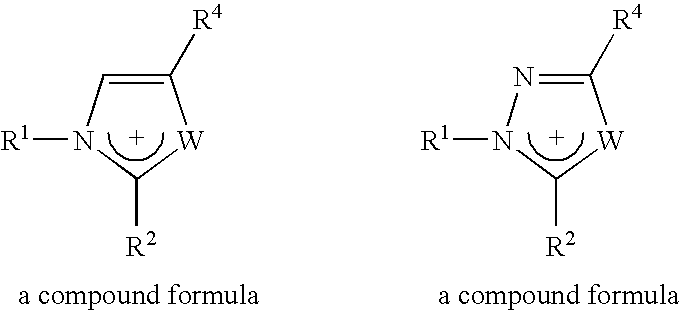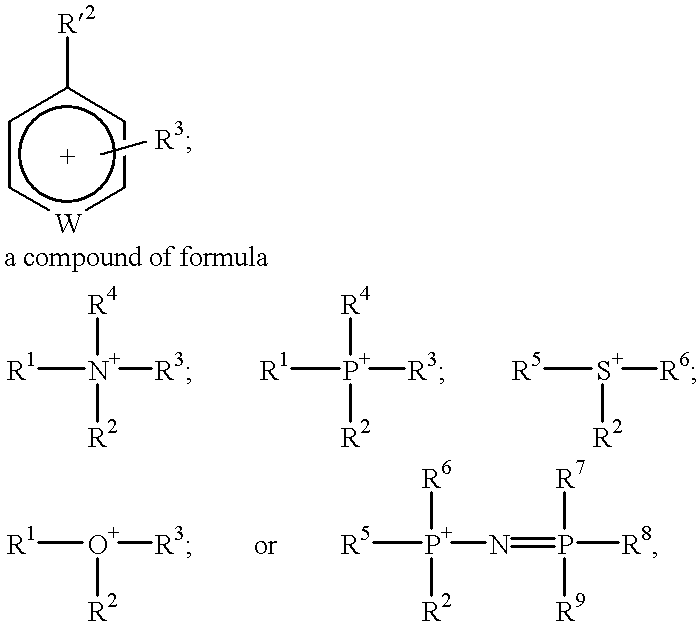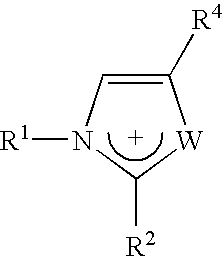Materials useful as electrolytic solutes
a technology of electrolysis and materials, applied in the field of ionic compositions, can solve the problems of limiting the redux or acido-basic stability domain of the compound, hygroscopic and corrosive, and no interest, and achieve the effect of low melting poin
- Summary
- Abstract
- Description
- Claims
- Application Information
AI Technical Summary
Benefits of technology
Problems solved by technology
Method used
Image
Examples
example 1
15 g of 1-methyl-3-ethyl imidazolium chloride EMICl (C6H11N2Cl) are dissolved in 100 ml of water to which are added 23 g of potassium bis-fluorosulfonimidide (KFSI) K[(FSO2)2N]. A separation in two liquid phases is immediately obtained. The molten salt of 1-methyl-3-ethyl imidazolium bis-fluorosulfonimidide (EMIFSI) is extracted with dichloromethane and dried with anhydrous magnesium sulfate. The suspension is filtered and the solvent evaporated. The salt is dried under vacuum at 80° C., and corresponds to the developed formula:
This ionic compound examined under DSC presents a melting point of −15° C. The weight loss measured by differential thermal analysis (DTA) under argon is lower than 1% up to 350° C. The conductivity and the function of the temperature are provided in Table 1 below.
TABLE 1Temperature (° C.)−100102030405060Conductivity (mScm−1)5.68.3111520253137σ (FSI) / σ TFSI (%)2.412.212.011.861.801.701.671.64
The conductivity is higher than that obtained with the 1-methyl-3-e...
example 2
Lithium bis-difluorophosphonylamidide Li[(POF2)2N] is prepared according to the method of Fluck and Beuerle in Z. Anorg. Allg. Chem., 1975, 412, 65, by reacting the lithiated derivative of hexamethyldisilazane on phosphorus oxyfluoride according to the following reaction:
2 POF3+Li[Si(CH3)3]2N2 FSi(CH3)3+Li[(POF2)2N]
The molten ionic salt 1-methyl-3-ethyl imidazolium bis-difluorophosphonylamidide is prepared by ionic exchange in water according to Example 1 between 10 g of 1-methyl-3-ethyl imidazolium chloride and 13 g Li[(POF2)2N] and extraction with dichloromethane. The molten salt has physical / chemical properties similar to that of the fluorosulfonyl of Example 1.
example 3
Different imidazolium salts of general formula:
have been prepared with anions [(FSO2)2N]− and [(POF2)2N]−, and are illustrated in Table 2 below. Those with the sign “+” are liquid salts at room temperature.
TABLE 2R3 =CH3C2H5C3H7C4H9C5H11C7H15C8H17R1 = CH3, R2 = H++++++R1 = CH3, R2 = CH3+++++R1 = C2H5, R2 = H+++++++R1 = CH3, R2 = C3H3+++++++
PUM
| Property | Measurement | Unit |
|---|---|---|
| Fraction | aaaaa | aaaaa |
| Angle | aaaaa | aaaaa |
| Specific surface area | aaaaa | aaaaa |
Abstract
Description
Claims
Application Information
 Login to View More
Login to View More - R&D
- Intellectual Property
- Life Sciences
- Materials
- Tech Scout
- Unparalleled Data Quality
- Higher Quality Content
- 60% Fewer Hallucinations
Browse by: Latest US Patents, China's latest patents, Technical Efficacy Thesaurus, Application Domain, Technology Topic, Popular Technical Reports.
© 2025 PatSnap. All rights reserved.Legal|Privacy policy|Modern Slavery Act Transparency Statement|Sitemap|About US| Contact US: help@patsnap.com



